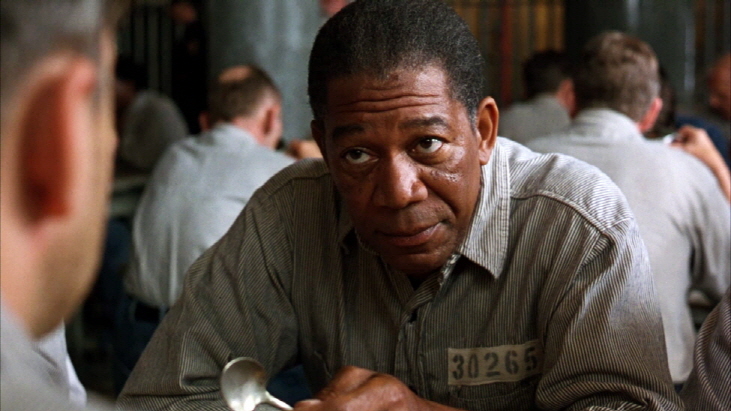It has been nearly 30 years since I watched Frank Darabont’s “The Shawshank Redemption” for the first time. As far as I remember, I watched it at least three times, and I saw it again a local movie theater yesterday thanks to the 30th anniversary re-release in South Korea, but the movie remains a powerful human drama about hope and redemption. Although I remember quite well most of its key moments, they still engaged and then touched me as before, and I marveled about how the movie organically flows along these moments before eventually arriving at its expected ending.
The main interest of the movie, which is based on Stephen King’s novella “Rita Hayworth and Shawshank Redemption”, lies on how Andy Dufresne (Tim Robbins) succeeds in getting away from where he was imprisoned for almost 20 years. He was once a successful young banker in the late 1940s, but then he was wrongfully accused of killing his wife and her lover, and that consequently led to being sentenced to life in prison mainly because there is no evidence to prove his innocence.
When Andy is subsequently sent to the Shawshank Prison, he happens to draw the attention of Ellis Boy “Red” Redding (Morgan Freeman), an old-timer who has operated as a contraband smuggler in the prison. Andy’s story is mainly told through Red’s seasoned viewpoint, and, just like us, he also cannot help but fascinated with Andy, who is usually calm, reserved, and elusive regardless of whatever he is thinking or feeling inside his mind.
Just like many other prison movies, the movie surrounds Andy’s story with a bunch of various stock characters you can expect from your average prison drama flick. Under the firm and brutal supervision of the warden and his guards, all of the prisoners have to endure in one way or another everyday, and Red and many of his several close friends, who are naturally colorful in each own way, have been accustomed to their confined status. In case of Brooks Hatlen (James Whitmore), this old prisoner has spent so many years inside the prison that he becomes quite panic when he is notified that he is finally going to be released on parole, and that leads to one of the most heartbreaking moments in the film.
Quite well aware of how much he is stuck with his prison life, Red has simply given up the possibility of hope and freedom as shown from his recurring scenes with the parole board, but then he finds himself affected a lot by his unexpected friendship with Andy. At first, Andy simply approaches to him for some little help, but it does not take much time for them to befriend more each other while Andy becomes a crucial figure for the warden and those prison guards thanks to his vast knowledge on financial and tax business. As a result, Andy can be a lot safer in the prison while also getting some more benefit, and Red gladly goes along with that.
Of course, we gradually come to sense that Andy is planning something behind his back, and Darabont’s screenplay wisely lets us keep guessing as leisurely taking its time in building its story and characters more. Steadily engaging us with his low-key charm, Tim Robbins ably conveys to us his character’s considerable will and intelligence, and he is particularly good when his character gives a little but important moment for his fellow inmates via one of the famous opera works from Wolfgang Amadeus Mozart. Andy surely knows the consequence of his rather impulsive action from the beginning, and we can clearly see that he believes it is really worthwhile to do for him as well as other prisoners out there.
When it eventually reaches the dramatic climax part along with Andy during its final act, the movie does not disappoint us at all, and its technical aspects are top-notch to say the least. Cinematographer Roger Dickens, who incidentally received his first Oscar nomination for this movie, gives us a number of effective visual moments as filling the screen with the subtle tone of confinement and oppression, and that is further enhanced by the score by Thomas Newman, who also received his first Oscar nomination for the film (How many more nominations will he have to endure before finally winning an Oscar, I wonder?).
On the opposite, Morgan Freeman, who received a well-deserved Oscar nomination for his performance here in this film (The movie received seven Oscar nominations including the one for Best Picture, by the way), does much more than holding the ground for Robbins. As he would do again in “Se7en” (1995) and “Million Dollar Baby” (2004), he sets the tone and attitude of the movie with his own voice and presence from the beginning, and he comes to function as the heart of the film as his character is gradually changed and transformed by the positive influence from his accidental friend along the story. Around the finale, Freeman gives a rather brief but powerfully human moment when Red is brought to the parole board again, and we are not so surprised at all by what happens next, while also impressed by how poignantly Freeman handles this introspective moment.
In conclusion, “The Shawshank Redemption”, which has been the number 1 movie in the IMDB movie ranking during last several years, distinguishes itself from other similar prison drama movies via its sublime humane qualities. I have admired it more and more as observing how it has gradually been embraced as a classic movie by many other audiences, and I am glad to report to you that it is as timeless as many other great films in addition to being on the top of its genre field.










